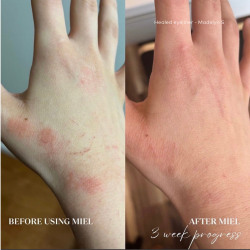We are here to talk about Combating Psoriasis due to the fact that so many people around the world are afflicted with this disease. It is used for moisturizing and treating hot spots and flare-ups in the areas affected by psoriasis. Our mission is to better inform you and to see if we can inform you of another option that we have found. Because this is such a nasty skin disease, we would like to give you some relief whenever possible. So here is a bunch of information about psoriasis for those who are interested. For others who just want relief, here you go….
What is Psoriasis?
According to WebMD, psoriasis is a skin disorder that causes skin cells to multiply up to 10 times faster than normal. This makes the skin build up into bumpy patches. On lighter skin, the patches can be red with white scales. On darker skin, the patches can be purplish, violet, or brown with gray scales. They can grow anywhere, but most appear on the scalp, elbows, knees, and lower back. Psoriasis can’t be passed from person to person. It does sometimes happen in members of the same family.
Health Insurance While Combating Psoriasis is Difficult:
Living with Psoriasis and Psoriatic Arthritis might include paying large out-of-pocket expenses, having limited coverage, frequently having rejections, and generally not knowing what choices there are for treatment. These may obstruct your ability to get the necessary medical care and prescription drugs. Getting the care you need might be difficult when Dealing with Health Insurance because of its complexity.
The world of health insurance may be confusing for a lot of individuals. The path to appropriate therapy may seem more difficult if you suffer from a chronic illness like psoriasis or psoriatic arthritis. Although treatment for psoriasis or psoriatic arthritis might be costly, this shouldn’t stop you from finding Good Health Insurance.
Combating Psoriasis and Symptoms to Look Out For:
Psoriasis symptoms might flare up for a few weeks or months at a time, then fade or disappear for longer periods of time. Psoriasis can be treated in a variety of ways, with the severity and type of your problem determining the course of your treatment. While mild psoriasis can be adequately treated with creams or ointments such as Healing Skin Balm, moderate to severe psoriasis may require medication, injections, or light therapy. Controlling common triggers, such as skin injuries and stress, can also help with dealing with symptoms.
Psoriasis symptoms differ from person to person; however, some typical ones are listed below:
- Patches of thick, red skin are covered in silvery-white scales. That itch or burn at the elbows, knees, scalp, trunk, palms, and soles of the feet,
- Dry, cracked skin that itches or bleeds.
- Nails that are thick, ridged, and pitted.
- Insufficient sleep.
Psoriasis patients also have the chance of having additional severe illnesses, such as:
- Psoriatic arthritis is a persistent kind of arthritis characterized by joint pain, swelling, and stiffness, as well as entheses, the areas where tendons and ligaments connect to the bones.
- A number of other cancers, including Crohn’s disease, diabetes, metabolic syndrome, obesity, osteoporosis, uveitis (inflammation of the center of the eye), liver disease, and kidney disease, may also be more common in people with psoriasis.
- Events related to the heart include heart attacks and strokes
- Mental health issues, including anxiety, depression, and poor self-esteem.
Types of Psoriasis:
There are different types of psoriasis, including:
- Plaque psoriasis. This is the most common kind of psoriasis; it is a raised red patches of skin that are covered by silvery-white scales. The patches usually develop in a symmetrical pattern on the body and tend to appear on the scalp, trunk, and limbs, especially the elbows and knees.
- Guttate psoriasis. This type usually appears in children or young adults and looks like small red dots, typically on the torso or limbs. Upper respiratory tract infections, such as strep throat, can set off flare-ups.
- Pustular psoriasis. In this type, pus-filled bumps called pustules surrounded by red skin appear. It usually affects the hands and feet, but there is a form that covers most of the body. Symptoms can be triggered by medications, infections, stress, or certain chemicals.
- Inverse psoriasis. This form appears as smooth, red patches in folds of skin, such as beneath the breasts or in the groin or armpits. Rubbing and sweating can make it worse.
- Erythrodermic psoriasis. This is a rare but severe form of psoriasis characterized by red, scaly skin over most of the body. It can be triggered by a bad sunburn or taking certain medications, such as corticosteroids. Erythrodermic psoriasis often develops in people who have a different type of psoriasis that is not well controlled, and it can be very serious.
Combating Psoriasis with Healing Skin Balm:
Although there isn’t a cure for psoriasis at this time, there are therapies that help manage symptoms so you can go back to your regular activities and get better sleep. Your doctor will work with you to choose the best course of action, the severity and kind of psoriasis, as well as any potential drug side effects. The following might be part of your treatment:.
- Topical Therapies: People with mild to moderate illnesses are often treated with creams, ointments, lotions, foams, or solutions, especially those that contain corticosteroids. This is where I would recommend the Healing Skin Balm; it has no added scents and is made from all natural products. Some topical treatments include vitamin D-derived medications and retinoids (associated with vitamin A).
- Methotrexate: This medication comes in injectable or pill form and belongs to the class of medications known as antimetabolites. It slows down the development and division of cells and inhibits the immune system.
- Oral Retinoids. Some people with moderate-to-severe psoriasis may benefit from these compounds, which are connected to vitamin A. They have the potential to be used with phototherapy.
- Biologic Response Modifiers: By blocking particular immune molecules, these injectable drugs can reduce or even eliminate inflammation.
- Immunosuppressants: These medications, which function by weakening the immune system, are often reserved for severe patients.
- Oral Phosphodiesterase 4 (PDE4) Inhibitors: These decrease inflammation and the quick turnover of skin cells by targeting the enzymes found inside immune cells.
- Oral Tyrosine Kinase 2 (TYK2) Inhibitors: These medications block the activation of certain immune cells.
Phototherapy: During this procedure, you will be exposed to ultraviolet light on your skin at the doctor’s office. Phototherapy is often applied when the illness affects significant amounts of the skin.
Living with Psoriasis:
Combating psoriasis can affect a person’s day-to-day life, including work and sleep. However, health care providers understand the impact of the disease and can work with you to help reduce the symptoms. In addition to going to your doctor regularly, here are some things you can do to help manage your symptoms:
- Keep your skin well moisturized. Bathe in lukewarm water and use mild soap that has added oils. After bathing, apply Healing Skin Balm while your skin is still damp.
- Maintain a healthy weight and diet. Overweight makes the symptoms of psoriasis worse.
- Maintain a nutritious diet. Several psoriasis studies have found the Mediterranean diet to be good.
- If you smoke, develop a strategy to stop with your physician. According to studies, the symptoms usually get worse the more a person smokes.
- Don’t drink too much alcohol. According to certain research, drinking too much alcohol exacerbates symptoms.
- Give your skin a brief exposure to sunshine. While too much sun exposure could aggravate problems, a little sunshine can help with them. See your doctor for assistance.
- Steer clear of recognized triggers. Determine what causes flare-ups of psoriasis and take steps to prevent it. Certain medications, infections, stress, cold weather, and skin injuries have all been linked to flare-ups, according to a number of studies.
- Participate in a support group or see a mental health professional. Many people may feel self-conscious about their looks due to the scaly areas of skin. An individual’s mental health may be impacted by psoriasis, raising their risk of anxiety and despair. You may learn more about managing and living with the illness by seeking support.
Combating Psoriasis for Life:
Different varieties of psoriasis might appear differently, but the most common variety is characterized by silvery, scaly lesions that may itch. Although there is no known cure for psoriasis, we recommend Healing Skin Balm because it might not be curable yet. But Combating Psoriasis will keep it down, at least most the time. 🙂
Healing Skin Balm has a lot of uses for the skin, healing not just the surface but the root or deep into the subdermal layers of the skin. It is used for moisturizing and treating hot spots and flare-ups in the areas affected by psoriasis, rosacea, and eczema. Also to treat cuts and other blemishes, such as acne, razor burns, pimples, and cold sores. Ingrown hairs anywhere on the body, even diaper rash, or if you find part of your body with dry skin, it is a great moisturizer as well.
One of the fun uses of this skin balm is for the Aftercare of Tattoos & Surgeries. It is so soothing, and with it’s healing properties, it is perfect for these activities. It is used, especially for Mastectomy Aftercare Surgeries where the surgeon repairs and does the areola restoration. The Healing Skin Balm is vital for the healing of scar tissue.
Combating More Than Just Psoriasis:
One of the awesome things about our Healing Skin Balm is it’s versatility. You see, it is very effective for Aftercare for Tattoos and Surgeries where there is going to be some scarring. It does great on diaper rashes, cuts, abrasions, and acne. But that’s not all; it is also a very effective tool for Combating Psoriasis, Rosacea, and Eczema, as well as other skin diseases.
—–###—–



